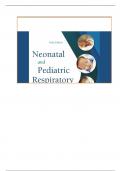Neonatal and Pediatric Respir
6 6 6
atory Care 5th EditionWalsh
6 6 6 6 6
Test Bank A+
6 6
, Chapter 1: Fetal Lung Development Test Bank
6 6 6 6 6 6
MULTIPLE6CHOICE
1. Which6of6the6following6phases6of6human6lung6development6is6characterized6by6the6
formation6of6a6capillary6network6around6airway6passages?
a. Pseudoglandular
b. Saccular
c. Alveolar
d. Canalicular
ANS:6D
The6canalicular6phase6follows6the6pseudoglandular6phase,6lasting6from6approximately6176weeks6t
o6266weeks6of6gestation.6This6phase6is6so6named6because6of6the6appearance6of6vascular6channels,6
or6capillaries,6which6begin6to6grow6by6forming6a6capillary6network6around6the6air6passages.
During6the6pseudoglandular6stage,6which6begins6at6day6526and6extends6to6week6166of6gestation,6t
he6airway6system6subdivides6extensively6and6the6conducting6airway6system6develops,6ending6wit
h6the6terminal6bronchioles.6The6saccular6stage6of6development,6which6takes6place6from6weeks6296
to6366of6gestation,6is6characterized6by6the6development6of6sacs6that6later6become6alveoli.
During6the6saccular6phase,6a6tremendous6increase6in6the6potential6gas-
6exchanging6surface6area6occurs.6The6distinction6between6the6saccular6stage6and6the6alveolar6st
age6is6arbitrary.6The6alveolar6stage6stretches6from6396weeks6of6gestation6to6term.6This6stage6is6
represented6by6the6establishment6of6alveoli.
REF:6pp.63-5
2. Regarding6postnatal6lung6growth,6by6approximately6what6age6do6most6of6the6alveoli6that6
will6be6present6in6the6lungs6for6life6develop?
a. 66months
,b. 16year
c. 1.56years
d. 26years
ANS:6C
Most6of6the6postnatal6formation6of6alveoli6in6the6infant6occurs6over6the6first61.56years6of6life.6At626
years6of6age,6the6number6of6alveoli6varies6substantially6among6individuals.6After626years6of6age,6
males6have6more6alveoli6than6do6females.6After6alveolar6multiplication6ends,6the6alveoli6continue6
to6increase6in6size6until6thoracic6growth6is6completed.
REF:6p.66
3. The6respiratory6therapist6is6evaluating6a6newborn6with6mild6respiratory6distress6due6to6
tracheal6stenosis.6During6which6period6of6lung6development6did6this6problem6develop?
a. Embryonal
b. Saccular
c. Canalicular
d. Alveolar
ANS:6A
The6initial6structures6of6the6pulmonary6tree6develop6during6the6embryonal6stage.6Errors6in6develo
pment6during6this6time6may6result6in6laryngeal,6tracheal,6or6esophageal6atresia6or6stenosis.6Pulmo
nary6hypoplasia,6an6incomplete6development6of6the6lungs6characterized6by6an6abnormally6low6nu
mber6and/or6size6of6bronchopulmonary6segments6and/or6alveoli,6can6develop6during6the6pseudogl
andular6phase.6If6the6fetus6is6born6during6the6canalicular6phase6(i.e.,6prematurely),6severe6respirato
ry6distress6can6be6expected6because6the6inadequately6developed6airways,6along6with6insufficient6a
nd6immature6surfactant6production6by6alveolar6type6II6cells,6gives6rise6to6the6constellation6of6prob
lems6known6as6infant6respiratory6distress6syndrome.
, REF:6 p.66
4. Which6of6the6following6mechanisms6is6(are)6responsible6for6the6possible6association6
between6oligohydramnios6and6lung6hypoplasia?
I. Abnormal6carbohydrate6metabolism
II. Mechanical6restriction6of6the6chest6wall
III. Interference6with6fetal6breathing
IV. Failure6to6produce6fetal6lung6liquid
a. I6and6III6only
b. II6and6III6only
c. I,6II,6and6IV6only
d. II,6III,6and6IV6only
ANS:6D
Oligohydramnios,6a6reduced6quantity6of6amniotic6fluid6present6for6an6extended6period6of6time,6w
ith6or6without6renal6anomalies,6is6associated6with6lung6hypoplasia.6The6mechanisms6by6which6a
mniotic6fluid6volume6influences6lung6growth6remain6unclear.6Possible6explanations6for6reduced6q
uantity6of6amniotic6fluid6include6mechanical6restriction6of6the6chest6wall,6interference6with6fetal6b
reathing,6or6failure6to6produce6fetal6lung6liquid.6These6clinical6and6experimental6observations6po
ssibly6point6to6a6common6denominator,6lung6stretch,6as6being6a6major6growth6stimulant.
REF:6pp.66-7
5. What6is6the6purpose6of6the6substance6secreted6by6the6type6II6pneumocyte?




